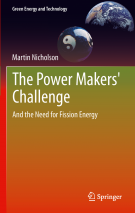
 Guest Post by Martin Nicholson. Martin studied mathematics, engineering and electrical sciences at Cambridge University in the UK and graduated with a Masters degree in 1974. He published a peer-reviewed book on low-carbon energy systems in 2012: The Power Makers’ Challenge: and the need for Fission Energy
Guest Post by Martin Nicholson. Martin studied mathematics, engineering and electrical sciences at Cambridge University in the UK and graduated with a Masters degree in 1974. He published a peer-reviewed book on low-carbon energy systems in 2012: The Power Makers’ Challenge: and the need for Fission Energy
———————-
In late April 2013, the Australian Energy Market Operator (AEMO) released its draft report titled 100 Per Cent Renewables Study – Draft Modelling Outcomes. The study was commissioned by the Department of Climate Change and Energy Efficiency (DCCEE) to explore future scenarios for the National Electricity Market (NEM) fuelled entirely by renewable resources.
AEMO provided scenarios for a 100 per cent renewable electricity supply at 2030 and 2050 along with the generation plant and the major transmission networks required to support each scenario. The study included estimated capital cost requirements for each scenario and an indicative estimate of the impact on customer energy prices.
AEMO found that a 100 per cent renewable system is likely to require much higher capacity reserves than a conventional power system. They estimated that the generation nameplate capacity could need to be over twice the maximum customer demand.
Assuming the reason for commissioning the report was to reduce greenhouse gas (GHG) emissions from electricity generation, it is disappointing that the DCCEE didn’t also request that nuclear power be included along with the renewable resources.
According to AEMO, to convert the NEM to a 100 per cent renewable system will cost at least $219 to $332 billion. This is excluding significant costs for the land (which could be as much as 5,000 sq kms) and augmentation of the distribution network. This is starting to sound worse than the recent high-speed train proposal from Melbourne to Brisbane.
According to the Australian Energy Regulator, the current NEM has an installed capacity of 46 GW made up of 26 GW of coal plants, 9 GW of gas, 8 GW of hydro and just over 2 GW of wind.
The following analysis is partly based on a paper I will present at a conference in July this year.
If the primary aim of the DCCEE is to reduce emissions, replacing the coal plants with nuclear will do the job by reducing emissions from electricity generation from 196 Mt CO2-e in 2010 to 30 Mt in 2050; a reduction greater than the national target of 80 per cent by 2050.
What’s more important, based on the same BREE costing source used by AEMO for its study, replacing all the coal plants with nuclear power will cost only $91 billion. Less than half the lowest cost scenario for the 100 per cent renewable system. The savings come largely from reducing the need for additional capacity reserves demanded by the prevalence of intermittent technologies.
The AEMO study using 100 per cent renewables estimated wholesale electricity prices in the range of $111/MWh to $133/MWh. My wholesale electricity price estimate for a combination of nuclear and renewables, based on the CSIRO eFuture model, is in the range $124/MWh to $126/MWh. As this is in the middle of the AEMO range, wholesale prices are likely to be similar with or without nuclear.
As well as reducing capital costs, nuclear power for the NEM rather than a 100 per cent renewable system offers other benefits. Significant less land is required and there is less need to upgrade the transmission network. Land use in the USA for nuclear plants averages 3.6 sq kms per GW. So we could expect to use less than 100 sq kms of land rather than the 2,400 to 5,000 sq kms needed for the 100 per cent renewable system.
Also, more changes to the transmission network may be needed for the 100 per cent renewable system than one using nuclear. The costs of these network changes will be added to retail electricity prices.
It seems that the emissions reduction targets by 2050 can be achieved using nuclear power to replace coal at less than half the capital cost of a 100 per cent renewable system without increasing electricity prices.
It seems hardly surprising that countries like China, India, Russia and Korea are building nuclear plants as well as renewable energy systems given the cost and other resource savings.
Australia wants the lowest cost solution to reducing GHG emissions. The DCCEE must request AEMO to perform a further study to consider a scenario including nuclear power.
———-
Got a Comment?
To leave your comment and read other reactions, please go to the dedicated Discussion Thread on the BNC Forums:
http://bravenewclimate.proboards.com/index.cgi?action=display&board=bncblogposts&thread=394
Filed under: Emissions, Future, Renewables, Scenarios






.png)







All comments should be posted here:
http://bravenewclimate.proboards.com/index.cgi?action=display&board=bncblogposts&thread=394